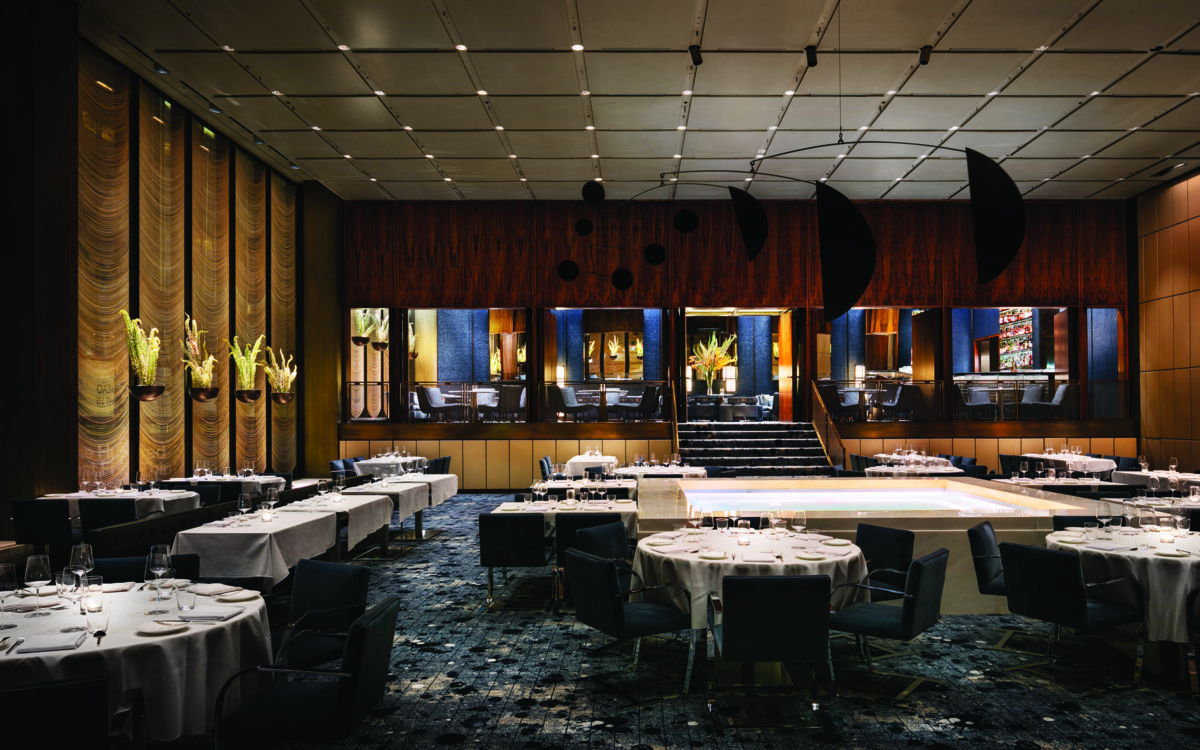The Season Finale
by Kyle Chayka

The Pool, formerly the Pool Room of the Four Seasons. 2017. Photo: Scott Frances.
“We insist on having the best of everything,” a restaurant executive told the New Yorker upon the 1959 opening of the Four Seasons, the midtown Manhattan restaurant that became synonymous with the power lunch for a half-century. At the time, “the best” was a kind of Gesamtkunstwerk of high design: furniture by Eero Saarinen, paintings by Jackson Pollock (though not Mark Rothko, who pulled his commission), and an interior by Philip Johnson, who brocaded the glass window-walls of Mies van der Rohe’s Seagram Building with metal curtains. The wood-paneled Grill Room, up front, was like eating inside a modernist gingerbread house; and the Pool Room, with its open body of water sunk in Carrara marble, had an air of slight lasciviousness that might explain its historic charm. It was where you went to be tasteful, important, sexy, and rich all at the same time, and to be seen doing so.
But the nature of style is to fade. The Four Seasons’s aging crowd and lack of culinary (as opposed to aesthetic) innovation began to show, and by 2015 Aby Rosen, the art collector and current owner of the Seagram Building, let the restaurant know he would not be renewing its lease. Rosen had already proved himself a provocateur by removing the Picasso tapestry, Le Tricorne, that had hung in the interstitial hallway of the Four Seasons under the cover of a repair job. His choice of a new tenant was similarly iconoclastic: Major Food Group is better known for its upscaled reinterpretations of comfort food — price-inflated red sauce at Carbone and bagels with bottle service at Sadelle’s — than artistic accomplishment.
What to make, then, of the new Four Seasons, scrubbed clean after a $33 million renovation and rechristened as two separate restaurants, The Grill and The Pool? I started a recent evening there in the Pool, where a new bar has been carved out of a former private room and a captain in a dramatic white Tom Ford dinner jacket clucked over its few guests. The post-restoration vibe here is decidedly Seaworld. Knoll club chairs covered in bluish horsehair cluster around low tables. The liquor shelves behind the bar are backlit and mirrored. “Sour apple” features on the cocktail list. The custom carpet would be entirely unnoticeable in any major airport; strange, as the carpet was one of the few interior elements not protected by landmark designation. (Rosen hired the luxury-minimalist architect Annabelle Selldorf, responsible for the white cubes of David Zwirner and Hauser & Wirth, to handle the restoration, and commissioned his personal architect, William T. Georgis, for the interior design.) The Picasso curtain has been replaced by a Pinterest-ready plant-wall sculpture by Paula Hayes. In its superficial whimsy, it seems to play into the very attitudes Rosen despises. “Nowadays people need to be somewhere 10 minutes to take an image, and then they feel like they’re done. It sucks!” he told Town & Country soon after the restaurants opened. “I have very good taste.”

The new Grill is the team’s more faithful restoration. The dining room has the same geometric composition of white-clothed tables abutting the tall, square bar, though now they are filled up in the evening as well as at lunchtime. Knoll replicated the curvilinear barstools that Mies and Johnson designed for the original, and Richard Lippold’s abstract sculpture of hanging rods still hangs above, though it’s been theatrically relit. Bartenders in more Tom Ford perform glamorously, but a martini comes from a crystal decanter; it was premixed some time in the past week, the bartender informs me, as if this routine added to the drink instead of killing it. A screwdriver, with Seville oranges and blossom, is another option.
Bronze and wood dominate the furnishings; white and blonde are the primary hair colors. Rosen and Major Food Group are working to capture a new crowd of New York notables, but the current demographic is old, more banking and real estate than media or the ascendant startup class. (Though now even the bankers and brokers dress in t-shirts.) Easy to say that the barbarians have invaded — but the truth is that the modernist aesthetic itself has decayed, decentralized, and distributed itself into the mainstream, such that this town’s new elite has no need to trek to Park Avenue for the original. A pitch-perfect recreation of midcentury modernism seems markedly less interesting when TGI Fridays is kitting out restaurants with Danish blond wood, and Target is launching its own line of faux midcentury furniture. Leather, bronze, dark wood, low tables: these are now the tropes of a mid-market hotel lobby, and the Grill and the Pool are more like interactive museum dioramas than efforts of their own. The environment seems to be more about role-playing a bygone era, a Mad Men redux a few years too late even for Mad Men.
It doesn’t seem worth wasting nostalgia on the social scene of the original Four Seasons, with Tina Brown hatching deals in this corner and Henry Kissinger kibitzing in that one, but the space did achieve a peak of holistic architectural and interior design that hasn’t been matched in a New York restaurant since. It was a perfect representation of its time — a time that has now firmly ended. Manhattan’s 2017 version of the Four Seasons, the purest representation of our current aesthetic pretensions, would be far different from this. One imagines instead a stark white temple, designed by Rem Koolhaas, say, in which organic Soylent is dispensed by conveyor belt. Venture capitalists and tech entrepreneurs discuss platform transactions while sitting on stools of reclaimed wood. Reservations, menus, ordering, and checks by iPhone only. Something to fit our collective apathy and anhedonia, the luxury of no luxury.